Construction Establishments Generate Employment Reaching 156,202
-
In 2001, the total number of construction establishments nationwide was estimated at 2,691. Of the total establishments count, more than three-fourths (2,022 establishments or 75.1 percent) were construction establishments with average total employment (ATE) of less than 20 workers and the remaining 24.9 percent (669 establishments) were composed of establishments with ATE of 20 or more workers.
-
General engineering construction establishments constitute almost half (1,340 or 49.8 percent) of the total number of establishments. Building installation and non-residential building construction establishments, numbered 477 or 17.7 percent and 464 or 17.2 percent, respectively. Figure 1 illustrates the distribution of establishments by industry for the construction sector.
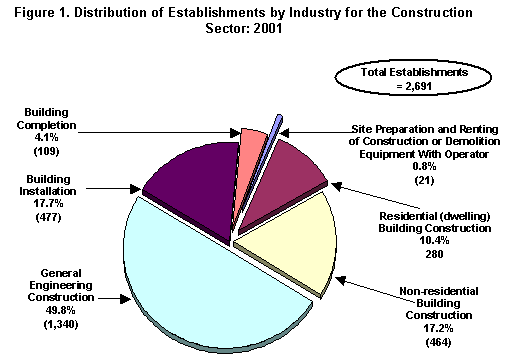
-
Total employment generated by the sector in 2001 reached 156,202. Of these, more than half (96,811 workers or 62 percent) worked in general engineering construction; 16.5 percent (25,752 workers) in non-residential building construction; and 13.7 percent (21,416 workers) in building installation construction. The rest, with a combined number of 12,222 workers or 7.8 percent, were employed in site preparation, residential building construction and building construction completion industries. Figure 2 shows the distribution of employment by industry.
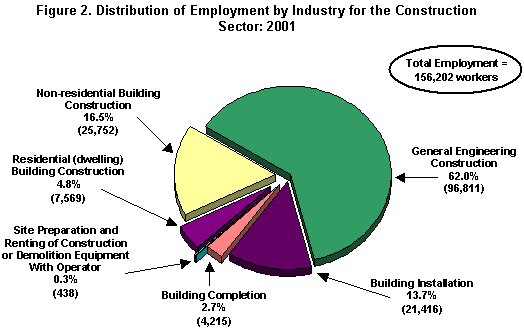
Average Monthly Compensation is P7,351 per Construction Worker
-
Total compensation disbursed amounted to P13.6 billion, translating to an average monthly compensation of P7,351 per construction worker..
-
By industry, residential building construction paid the highest average monthly compensation of P 9,149 per worker while building completion industry paid the lowest average monthly compensation of P 5,877. Figure 3 exhibits the average monthly compensation by industry.
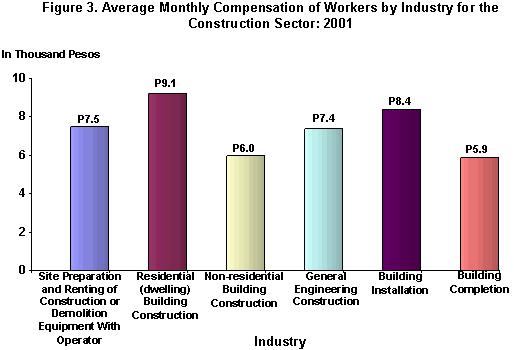
General Engineering Construction Industry Produces the Biggest Value of Output Worth P60.6 Billion
-
Total revenue earned by all construction establishments amounted to P92.6 billion while cost incurred was estimated at P66.6 billion.
-
Total value of output produced by all construction establishments was valued at P90.8 billion. Construction establishments with ATE of 20 or more workers accounted for 89.3 percent (P81.1 billion) of total value of output for the sector.
-
By industry, general engineering construction produced more than half (66.7 percent or P60.6 billion) of the total value of output for the sector. Figure 4 shows the distribution of value of output by industry.
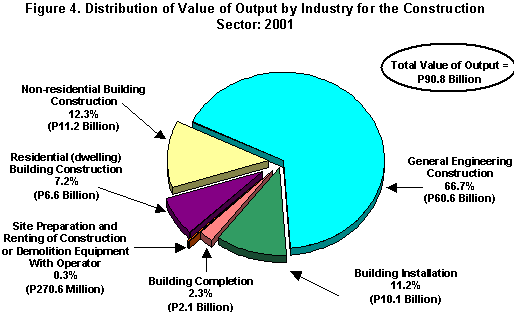
Residential Dwelling Construction Industry Registers the Highest Labor Productivity Valued at P 383,825
-
Labor productivity for the sector, measured as the ratio of census value added and number of paid employees, was estimated at P232,731.
-
Among industries, residential dwelling construction industry registered the highest labor productivity amounting to P383,825. This was followed by general engineering industry with an estimated value of P249,943. Figure 5 displays the labor productivity by industry.
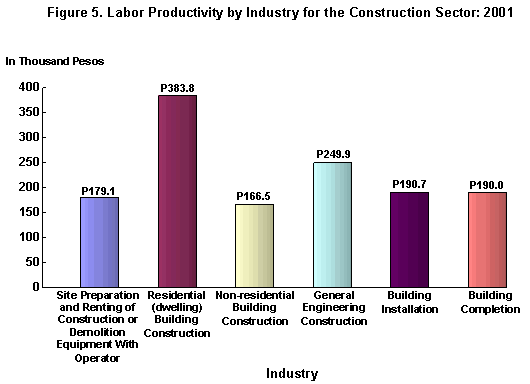
TECHNICAL NOTES
Scope and Coverage
The 2002 Annual Survey of Philippine Business and Industry (ASPBI) aimed to collect information on the levels, structure and trends of industries in the entire country. It has the calendar year, 2001, for its reference period. One of the fourteen (14) sectors covered in the survey is the construction sector.
All construction establishments with average total employment (ATE) of 100 and more workers were covered on a 100 percent basis and those with ATE of less than 100 workers were selected using simple random sampling.
Response Rate
The response rate is 89.4 percent of the 663 sample establishments for the construction sector. Adjustments for non-response were made through imputations.
Concepts and Definition of Terms
Establishments An economic unit under single ownership or control, i.e., under a single legal entity, engaged in one predominantly one kind of economic activity at a single fixed location, and having permanency of assets in its premises during the operation. It is also defined as the unit that is engaged in the production of the most homogenous group of goods and services, usually at one location, but sometimes over a wider area, for which separate records are available that can provide data concerning the production of these goods and services and the materials, labor and physical resources used in this production.
Construction Establishments General contractor engaged in the construction, repair or demolition of buildings, highways, airports and other structures; land leveling; earth moving and land reclamation; specialty contractor engaged in only specialized trade or craft like electrical installation, plumbing, painting, air conditioning, well drilling, installation of doors and windows and other work on component parts of the structure.
Economic activity or business is the activity of the establishment as classified under the 1994 Philippine Standard Industrial Classification (PSIC). Generally, the main activity of the establishment is the establishment's principal source of income. If the establishment is engaged in several activities, its main activity is that which earns the biggest income or revenue.
Average total employment (ATE) is the sum of the number of persons who worked in or for this establishment for all months of the year divided by 12, regardless of the number of months the establishment is in operation.
Total Employment includes all persons who worked in or for the establishment as of November 15, 2001.
Paid employees are all persons working in the establishment and receiving pay, as well as those working away from the establishment paid by and under the control of the establishment. Included are all employees on sick leave, paid vacation or holiday. Excluded are consultants, home workers, workers receiving pure commissions only and workers on indefinite leave.
Working owners are owners who are actively engaged in the management but do not receive regular pay, i.e., not included in the payrolls. Managers and directors of corporations working for pay are reported as managers. .
Total hours worked by construction workers refers to the number of hours actually spent by construction workers at work, including waiting time and overtime. It excludes time paid for but not spent in work for the establishment such as sick leave and paid vacation leave.
Unpaid workers are persons working for at least one third of the working time normal to the establishment and do not receive regular pay.
Salaries and wages are payments in cash or in kind to all employees, prior to deductions for employee?s contributions to SSS/GSIS, withholding tax, etc. Included are total basic pay, overtime pay and other benefits.
Overtime pay are payments given for extra hours worked.
Other benefits include bonuses, cost of living allowances, commutable transportation and representation allowances, food, housing, commissions paid to salaried employees, separation, retirement, terminal pay, gratuities, etc. Excluded are cost of uniform/working clothes and reimbursable transportation and representation allowances.
Employer's Contribution to SSS/GSIS and the like refers to payments made by the establishment on behalf of the employees. Examples are SSS, GSIS, Employees Compensation Commission (ECC), Philhealth and PAGIBIG.
Revenue includes cash received and receivables for goods sold and services rendered. Valuation is at producer's prices (ex-establishment), net of discounts and allowances, including duties and taxes but excluding subsidies.
Value of output represents the total value of products sold, receipts from contract work and industrial services done for others, receipts from goods sold in the same condition as purchased, fixed assets produced on own account and change in inventories (ending less beginning) of finished goods, work-in-process and goods for resale.
Cost refers to all expenses incurred during the year whether paid or payable. Valuation is at market prices including taxes and other charges, net of rebates, returns and allowances. Goods and services received by the establishment from other establishments of the same enterprise are valued as though purchased.
Employer's Contribution to SSS/GSIS and the like refers to all expenses incurred during the year whether paid or payable. Valuation is at market prices including taxes and other charges, net of rebates, returns and allowances. Goods and services received by the establishment from other establishments of the same enterprise are valued as though purchased.
Indirect taxes refer to all taxes, other than income tax, incidental to the production or sale of goods and services, which are chargeable as expenses including business license, BIR stamps, real estate tax and other local taxes.
Subsidies are all special grants in the form of financial assistance or tax exemption or tax privilege given by the government to aid and develop an industry or production and to protect it against competition.
Fixed assets are physical assets expected to have productive lives of more than one year and intended for use and/or being used by the establishment. Included are land, buildings, other structures and land improvements, transport equipment , machinery and equipment, furniture, fixtures, and other fixed assets.
Book value of fixed assets is the initial value or acquisition cost of fixed assets less the accumulated depreciation.
Depreciation is the total amount set aside for the year to cover the decrease in value of fixed assets owned by the establishment because of foreseen obsolescence, wear and tear as a result of operation and normal amount of accidental damage.
Fixed assets produced on own account refer to the physical assets produced by the establishment for its own use. It is valued at the cost of all work put in place, including overhead.
Capital expenditures for fixed assets include cost of acquisition of new and used fixed assets; fixed assets produced by the establishment for its own use; major alterations, additions and improvements to fixed assets, whether done by others or on own account. Fixed assets received from other establishments belonging to the same enterprise are valued as though purchased.
Gross addition to fixed assets is equal to capital expenditures less sale of fixed assets, including land.
Inventories refer to the stock of goods owned by and under the control of the establishment as of a fixed date, regardless of where the stocks are located. Valuation should be at current replacement cost in purchaser?s (market) prices. Replacement cost is the cost of an item in terms of its present price rather than its original cost.
Finished products inventory refer to the goods made by the establishment which are ready for sale/shipment as of a reference date. Valuation is at producer's price.
Work-in-process inventory refers to the value of all materials which have been partially processed by the establishment but which are not usually sold or turned over to other establishment without further processing. Valuation is at producer's price.
Change in inventories is computed as the total value of ending inventory less the total beginning inventory.
Census value added represents the difference between the value of output and total costs of materials and supplies consumed, fuels purchased, electricity purchased, industrial services done by others and goods purchased for resale.
Value added represents the sum of census value added and value of non-industrial services done for others less the cost of non-industrial services done by others and other costs.
Detailed Statistical Tables
The detailed tables at the national and regional levels of the 2002 ASPBI Construction sector are available upon request from the Industry Statistics Division, National Statistics Office, 4th Floor Solicarel Bldg II, Ramon Magsaysay Blvd., Sta. Mesa, Manila Tel. No. (062) 716-39-32.
Source: National Statistics Office
Manila, Philippines
